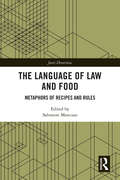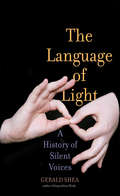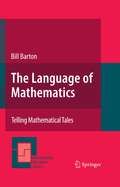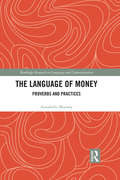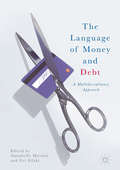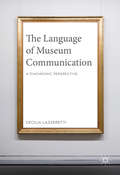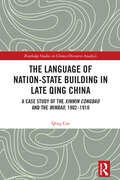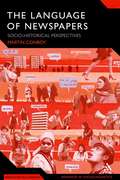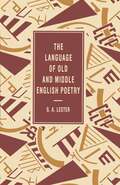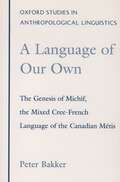- Table View
- List View
The Language of Law and Food: Metaphors of Recipes and Rules (Juris Diversitas)
by Salvatore MancusoThis book reconsiders the use of food metaphors and the relationship between law and food in an interdisciplinary perspective to examine how food related topics can be used to describe or identify rules, norms, or prescriptions of all kinds. The links between law and food are as old as the concept of law. Many authors have been using such links in creative ways to express specific features of law. This is because the language of food and cooking offers legal thinkers and teachers mouth-watering metaphors, comparing rules to recipes, and their combination to culinary processes. This collection focuses on this relationship between law and food and takes us far beyond their mere interaction, to explore different ways of using these two apparently so diverse elements to describe different phenomena of the legal reality. The authors use the link between food and law to describe different aspects of the legal landscape in different areas and jurisdictions. Bringing together metaphors and indirect correlations between law and food, the book explores different models of approaching legal issues and considering different legal challenges from a completely new perspective, in line with the multidisciplinary approach that leads comparative legal studies today and, to a certain extent, revisiting and enriching it. With contributions in English and French, the book will be of interest to academics and researchers working in the areas of law and food, law and language, and comparative legal studies.
The Language of Law School: Learning to "Think Like a Lawyer"
by Elizabeth MertzIn this linguistic study of law school education, Mertz shows how law professors employ the Socratic method between teacher and student, forcing the student to shift away from moral and emotional terms in thinking about conflict, toward frameworks of legal authority instead.
The Language of Law School: Learning to "Think Like a Lawyer"
by Elizabeth MertzIn this linguistic study of law school education, Mertz shows how law professors employ the Socratic method between teacher and student, forcing the student to shift away from moral and emotional terms in thinking about conflict, toward frameworks of legal authority instead.
The Language of Leadership Narratives: A Social Practice Perspective
by Jonathan Clifton Stephanie Schnurr Dorien Van De MieroopFascination with leadership and its relation to world events seems to be ever growing, and leadership narratives are a key element through which leader identities are constructed. Contemporary research into leadership tends to recycle the same old myths of the heroic white male leader. By looking at stories told by leaders in Australasia, Asia, North America, the Middle East, and Africa, this book explores different aspects of leadership narratives. The Language of Leadership Narratives brings linguistics and leadership research together, showcasing different analytical and methodological approaches and enabling a more critical approach. Each chapter focuses on a specific area of leadership research, from dark leadership to gendered leadership. This book introduces the advantages of analysing leadership narratives as social practice and discusses some of the main themes in contemporary leadership research. This volume is key reading for scholars and students of linguistics, communication studies, and business studies, and for those working in business and intercultural communication in the workplace.
The Language of Leadership Narratives: A Social Practice Perspective
by Jonathan Clifton Stephanie Schnurr Dorien Van De MieroopFascination with leadership and its relation to world events seems to be ever growing, and leadership narratives are a key element through which leader identities are constructed. Contemporary research into leadership tends to recycle the same old myths of the heroic white male leader. By looking at stories told by leaders in Australasia, Asia, North America, the Middle East, and Africa, this book explores different aspects of leadership narratives. The Language of Leadership Narratives brings linguistics and leadership research together, showcasing different analytical and methodological approaches and enabling a more critical approach. Each chapter focuses on a specific area of leadership research, from dark leadership to gendered leadership. This book introduces the advantages of analysing leadership narratives as social practice and discusses some of the main themes in contemporary leadership research. This volume is key reading for scholars and students of linguistics, communication studies, and business studies, and for those working in business and intercultural communication in the workplace.
The Language of Light: A History of Silent Voices
by Gerald SheaA comprehensive history of deafness, signed languages, and the unresolved struggles of the Deaf to be taught in their unspoken tongue Partially deaf due to a childhood illness, Gerald Shea is no stranger to the search for communicative grace and clarity. In this eloquent and thoroughly researched book, he uncovers the centuries-long struggle of the Deaf to be taught in sign language—the only language that renders them complete, fully communicative human beings. Shea explores the history of the deeply biased attitudes toward the Deaf in Europe and America, which illogically forced them to be taught in a language they could neither hear nor speak. As even A.G. Bell, a fervent oralist, admitted, sign language is "the quickest method of reaching the mind of a deaf child." Shea’s research exposes a persistent but misguided determination among hearing educators to teach the Deaf orally, making the very faculty they lacked the principal instrument of their instruction. To forbid their education in sign language—the “language of light”—is to deny the Deaf their human rights, he concludes.
The Language of Living Matter: How Molecules Acquire Meaning (The Frontiers Collection)
by Bernd-Olaf KüppersThis book, by an eminent scientist and philosopher, provides strong evidence for the claim that language is a general principle of Nature, rooted exclusively in physical and chemical laws. The author’s radical idea inevitably leads us to view the essence, origin and evolution of life in a completely new light. It shifts the coordinates of our scientific world-view in favor of an overarching concept of language that is able to bridge the gap between matter and mind. At the same time, it removes a blind spot in the Darwinian concept of evolution. To justify this far-reaching idea, the book takes a long and deep look at our scientific and philosophical thinking, at language as such, at science’s claim to truth, and at its methods, unity, limits and perspectives. These are the cornerstones structuring the book into six thematically self-contained chapters, rounded off by an epilogue that introduces the new topic of Nature’s semantics. The range of issues covered is a testimony to how progress in the life sciences is transforming the whole edifice of science, from physics to biology and beyond. The book is aimed at a broad academic and general readership; it requires no mathematical expertise.
The Language of London: Cockney Rhyming Slang
by Daniel SmithThe definitive guide to the vibrant and inventive language of the East End, featuring history, trivia and anecdotes. Cockney rhyming slang originated as a secret code among the thieves of London's East End. Adopted by costermongers and market traders, it fast became a vibrant patois that defined a community, confused the police and evolved to include ever more colourful rhyming phrases. Constantly updated and added to ever since, and fostered by Londoners citywide, it has long enlivened the streets of one of the world's most quirky and fascinating capitals.Cockney Rhyming Slang explores the origins and meanings of both commonly used and lesser-known phrases, taking in traditional slang as well as modern additions. Combining history, trivia, quotes and anecdotes, it is the definitive guide to cockney rhyming slang for locals and language lovers alike.
The Language of Mathematics: Telling Mathematical Tales (Mathematics Education Library #44)
by Bill BartonThe book emerges from several contemporary concerns in mathematics, language, and mathematics education. However, the book takes a different stance with respect to language by combining discussion of linguistics and mathematics using examples from each to illustrate the other. The picture that emerges is of a subject that is much more contingent, much more relative, much more subject to human experience than is usually accepted. Another way of expressing this, is that the thesis of the book takes the idea of mathematics as a human creation, and, using the evidence from language, comes to more radical conclusions than most writers allow.
The Language of Money: Proverbs and Practices (Routledge Research in Language and Communication)
by Annabelle MooneyThrough a detailed examination of proverbs related to money, this book offers a comprehensive critique of the prevailing everyday ideologies and discourses on money and paves the way toward establishing a new set of proverbs more conducive to financial equality and human well-being. The volume explores a variety of contexts to demonstrate the different aspects of the money system and the linguistic and social structures embedded within them, including pay day loan websites, gambling, get rich self-help books, and new forms of currency. Unpacking this complex relationship between people, money, and language in contemporary society, this book is an ideal resource for students and scholars in language and communication, sociolinguistics, rhetoric, sociology, and media studies.
The Language of Money: Proverbs and Practices (Routledge Research in Language and Communication)
by Annabelle MooneyThrough a detailed examination of proverbs related to money, this book offers a comprehensive critique of the prevailing everyday ideologies and discourses on money and paves the way toward establishing a new set of proverbs more conducive to financial equality and human well-being. The volume explores a variety of contexts to demonstrate the different aspects of the money system and the linguistic and social structures embedded within them, including pay day loan websites, gambling, get rich self-help books, and new forms of currency. Unpacking this complex relationship between people, money, and language in contemporary society, this book is an ideal resource for students and scholars in language and communication, sociolinguistics, rhetoric, sociology, and media studies.
The Language of Money and Debt: A Multidisciplinary Approach
by Annabelle Mooney Evi SifakiThis book analyses the language that ordinary people employ when discussing money, debt and financial behaviour. It documents and critiques this language from an array of disciplinary perspectives, with chapters on children’s books, government infomercials, television poverty porn, the emotional experience of being indebted, and more. In doing so, it addresses common underlying questions concerning definitions of money and value, and scrutinises how people construct, negotiate and articulate meaning in these domains. This wide-ranging edited collection will be of interest to students and scholars of linguistics, sociology, communication, literature and anthropology.
The Language of Money and Debt: A Multidisciplinary Approach
by Annabelle Mooney Evi SifakiThis book analyses the language that ordinary people employ when discussing money, debt and financial behaviour. It documents and critiques this language from an array of disciplinary perspectives, with chapters on children’s books, government infomercials, television poverty porn, the emotional experience of being indebted, and more. In doing so, it addresses common underlying questions concerning definitions of money and value, and scrutinises how people construct, negotiate and articulate meaning in these domains. This wide-ranging edited collection will be of interest to students and scholars of linguistics, sociology, communication, literature and anthropology.
The Language of Museum Communication: A Diachronic Perspective
by Cecilia LazzerettiThis volume explores the evolution of the language of museum communication from 1950 to the present day, focusing on its most salient tool, the press release. The analysis is based on a corpus of press releases issued by eight high-profile British and American museums, and has been carried out adopting corpus linguistics and genre analysis methodologies. After identifying the typical features of the museum press release, new media more recently adopted by museums, such as web presentations, blogs, e-news, and social media, are taken into consideration, exploring questions such as how has the language of museum communication changed in order to face the challenge posed by new technologies? Are museum press releases threatened by new approaches used in contemporary public relations? Are the typical press release features still detectable in new genres? Drawing on insights from linguistics, discourse analysis, and museum communication this book will be of great value to researchers and practitioners of applied linguistics, sociolinguistics, and museum communication scholars.
The Language of Nation-State Building in Late Qing China: A Case Study of the Xinmin Congbao and the Minbao, 1902-1910 (Routledge Studies in Chinese Discourse Analysis)
by Qing CaoThe Language of Nation-State Building in Late Qing China investigates the linguistic and intellectual roots of China’s modern transformation by presenting a systematic study of the interplay between language innovation and socio-political upheavals in the final decade of the Qing Dynasty. This book examines the formations, internal tensions, and promotion of such macroconcepts as ‘nation people’ (guomin国民), nation (minzu民族), society (qun群), state (guojia国家) and revolution (gemin革命) as novel ideas borrowed from Europe but mediated through Meiji Japan. Using corpus-based discourse analysis of the full-text corpus (4.2 million words) of the two most influential periodicals Xinmin Congbao (新民丛报) and Minbao (民报), this book scrutinises the multi-faceted formulations of these concepts and their impact. It underscores the adaptation and appropriation of European post-enlightenment values to the socio-political conditions of late Qing society. The analysis centres on the epic debate (1905-07) between these two periodicals that offered two distinctive visions of future China. Comparable to the 18th century great debate between Edmund Burke and Thomas Paine on the French Revolution, the Chinese debate has hitherto attracted little scholarly attention outside China. Yet, the debate not only turned the tidal wave of the public opinion against the Manchu monarchy and contributed to its downfall in 1911; it has given rise to a radical current of intellectual thinking whose ramifications have been keenly felt throughout 20th century China. This book represents the first study in English on this press debate that contributes significantly to the intellectual foundation of modern China. This book will be useful and relevant to academics, postgraduate students and final year undergraduate students in the field of Chinese Studies, and anyone interested in the role of language in shaping modern intellectual history.
The Language of Nation-State Building in Late Qing China: A Case Study of the Xinmin Congbao and the Minbao, 1902-1910 (Routledge Studies in Chinese Discourse Analysis)
by Qing CaoThe Language of Nation-State Building in Late Qing China investigates the linguistic and intellectual roots of China’s modern transformation by presenting a systematic study of the interplay between language innovation and socio-political upheavals in the final decade of the Qing Dynasty. This book examines the formations, internal tensions, and promotion of such macroconcepts as ‘nation people’ (guomin国民), nation (minzu民族), society (qun群), state (guojia国家) and revolution (gemin革命) as novel ideas borrowed from Europe but mediated through Meiji Japan. Using corpus-based discourse analysis of the full-text corpus (4.2 million words) of the two most influential periodicals Xinmin Congbao (新民丛报) and Minbao (民报), this book scrutinises the multi-faceted formulations of these concepts and their impact. It underscores the adaptation and appropriation of European post-enlightenment values to the socio-political conditions of late Qing society. The analysis centres on the epic debate (1905-07) between these two periodicals that offered two distinctive visions of future China. Comparable to the 18th century great debate between Edmund Burke and Thomas Paine on the French Revolution, the Chinese debate has hitherto attracted little scholarly attention outside China. Yet, the debate not only turned the tidal wave of the public opinion against the Manchu monarchy and contributed to its downfall in 1911; it has given rise to a radical current of intellectual thinking whose ramifications have been keenly felt throughout 20th century China. This book represents the first study in English on this press debate that contributes significantly to the intellectual foundation of modern China. This book will be useful and relevant to academics, postgraduate students and final year undergraduate students in the field of Chinese Studies, and anyone interested in the role of language in shaping modern intellectual history.
The Language of New Media Design: Theory and Practice
by Radan Martinec Theo van LeeuwenThe Language of New Media Design is an innovative new textbook presenting methods on the design and analysis of a variety of non-linear texts, from websites to CD-Roms. Integrating theory and practice, the book explores a range of models for analyzing and constructing multimedia products. For each model the authors outline the theoretical background and demonstrate usage from students' coursework, commonly available websites and other multimedia products. Assuming no prior knowledge, the book adopts an accessible approach to the subject which has been trialled and tested on MA students at the London College of Communication. Written by experienced authors, this textbook will be an invaluable resource for students and teachers of new media design, information technology, linguistics and semiotics.
The Language of New Media Design: Theory and Practice
by Radan Martinec Theo van LeeuwenThe Language of New Media Design is an innovative new textbook presenting methods on the design and analysis of a variety of non-linear texts, from websites to CD-Roms. Integrating theory and practice, the book explores a range of models for analyzing and constructing multimedia products. For each model the authors outline the theoretical background and demonstrate usage from students' coursework, commonly available websites and other multimedia products. Assuming no prior knowledge, the book adopts an accessible approach to the subject which has been trialled and tested on MA students at the London College of Communication. Written by experienced authors, this textbook will be an invaluable resource for students and teachers of new media design, information technology, linguistics and semiotics.
The Language of Newspapers: Socio-Historical Perspectives (Advances in Sociolinguistics)
by Martin ConboyThis book charts the connections between the language of journalism in England and its social impact on audiences and social and political debates from the first emergence of periodical publications in the seventeeth century to the present day. It extends work done on the language of the media to include an historical perspective, adding to wider contemporary debates about the social impact of the media. It draws upon the field of historical pragmatics, while retaining a concentration on the development of a particular form of media language, the newspaper, and its role in refracting and contributing to social developments. Dialogue is created between sociolinguistics and journalism studies. It is ideally suited to advanced students in these areas and in linguistics and media studies in general.
The Language Of Newspapers (PDF)
by Danuta ReahThe Intertext series has been specifically designed to meet the needs of contemporary English Language Studies. The core book, Working with Texts, is the foundation text which provides an introduction to language analysis. It is complemented by a range of 'satellite' titles which provide students with hands-on practical experience of textual analysis through special topics. They can be used individually or in conjunction with Working with Texts. The Language of Newspapers explores the ways in which the press portrays current events. From the ideological bias of the press, to the role of headlines in newspaper articles and ways in which newspapers relate to their audience, the book provides a comprehensive analysis of newspaper language. The second edition has been substantially rewritten and includes a range of new texts. Features include: * a new introduction, taking account of recent developments in the media * recent newspaper articles on a range of subjects, from Jeffrey Archer's conviction to the journalist captured for suspected spying in Afghanistan * a new introduction, taking account of recent developments in the media * new activities and commentaries to support student-directed study * a 'further resources' section with details of on-line newspapers and websites to visit.
The Language of Old and Middle English Poetry (The Language of Literature)
by G.A. LesterThis book gives a linguistic overview of the first eight centuries of English poetry - years which produced such key works as Beowulf, Layaman's Brut and Sir Gawain and the Green Knight. It begins with chapters on the social and literary context, before turning in more detail to subjects such as poetic diction, rhymed and alliterative verse, borrowed words, recurrent phrases, rhetoric and linguistic variety. Aimed at the beginning student and general reader, the book seeks to enhance appreciation and enjoyment by making the linguistic resources of the poets better understood.
The Language of Organization (PDF)
by Robert Westwood Stephen Andrew LinsteadThe importance of communication for organizations has been an ongoing concern since management was first theorized. Yet language has tended to be viewed as simply a medium of communication - without language per se being theoretically problematized. This book enables a more critical exploration of the major theoretical positions on language and organization, explaining why language warrants a more central and considered place in organization studies. Language and Organization explains how various perspectives on the relationship between language and organization can be represented and explored. Concerned with issues such as power, knowledge and organizational discourse, this book will provide essential new links for a proper conceptualisation and understanding of organizations.
A Language of Our Own: The Genesis of Michif, the Mixed Cree-French Language of the Canadian Métis (Oxford Studies in Anthropological Linguistics)
by Peter BakkerThe Michif language -- spoken by descendants of French Canadian fur traders and Cree Indians in western Canada -- is considered an "impossible language" since it uses French for nouns and Cree for verbs, and comprises two different sets of grammatical rules. Bakker uses historical research and fieldwork data to present the first detailed analysis of this language and how it came into being.
The Language of Patient Feedback: A Corpus Linguistic Study of Online Health Communication (Routledge Applied Corpus Linguistics)
by Paul Baker Gavin Brookes Craig EvansThe Language of Patient Feedback provides a unique insight into a diverse range of issues related to healthcare. Through the comprehensive and detailed interrogation of 29 million words of online patient feedback on the NHS in England, as well as 11 million words of responses to the feedback from NHS providers, this book: Uses a combination of computer-assisted and human analysis (Corpus-Assisted Discourse Analysis) to examine the extent to which characteristics like age and gender result in different types of evaluation. Investigates why nurses, doctors, dentists and receptionists are associated with very distinct types of feedback. Demonstrates the ways that NHS staff respond to comments and what this reveals about underlying institutional ideologies and practices. Concludes with suggestions for key recommendations that the NHS could act upon to improve the overall level of care it provides, as well as reflecting on what patient evaluation can actually tell us. The Language of Patient Feedback is key reading for anyone undertaking research within corpus linguistics, discourse analysis and health communication.
